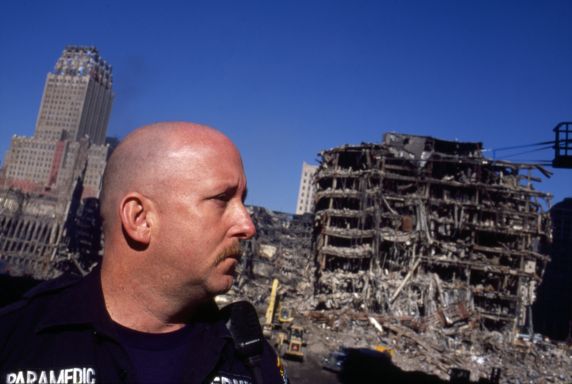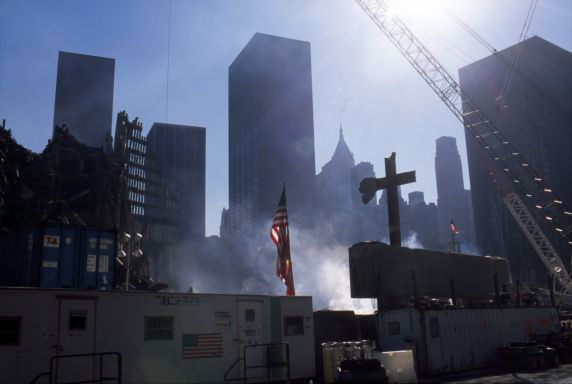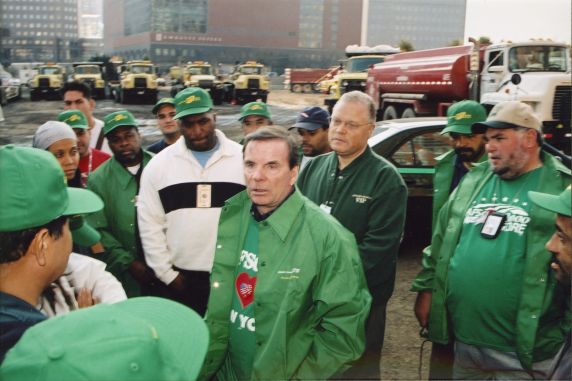AFSCME and September 11, 2001
Members of the American Federation of State, County and Municipal Employees (AFSCME) are drawn from a diverse range of professions and fields, including medical, sanitation, transportation, social work, clerical, and many others in the public service sector. Nothing in the union and the country’s history brought all of them together like the September 11, 2001 terrorist attacks and aftermath.
On that Tuesday morning, terrorists hijacked four airliners. One flew into the North Tower of the World Trade Center in New York City and a second plane flew into the South Tower. Within two hours of impact, both buildings and the rest of the World Trade Center complex collapsed. A third plane crashed into the Pentagon. Passengers on the fourth hijacked plane fought the terrorists and thwarted it from Washington, DC to a rural Pennsylvania field where it crashed. Two thousand, nine hundred and seventy-four innocent people died in the initial attack and many others died in the years after from health complications originating that day.
Nine AFSCME members were among the victims. New York Fire Department Chaplain, Reverend Mychal Judge, AFSCME Local 299 District Council 37, died while administering last rights to a mortally wounded firefighter inside one of the towers. AFSCME paramedics Ricardo Quinn and Carlos Lillo of Local 2507 DC 37, died while helping injured people in the towers. Five members of the AFSCME-affiliated Civil Service Employees Association (CSEA) Local 1000 who worked for the Department of Tax and Finance in the World Trade Center died: Yvette Anderson, Florence Cohen, Harry Goody, Marian “Marty” Hrycak, and Dorothy Temple. AFSCME member Chet Louie was at his second job in the World Trade Center and died that day as well. Others died in the years following from illnesses such as cancer likely caused by breathing in asbestos and other harmful substances while working on site. Many union members lost family members, friends, co-workers, and loved ones.
 The District Council 37 headquarters was one block away from Ground Zero, as the World Trade Center site became known, and staff had to find temporary offices. Current AFSCME President Lee Saunders was Administrator of DC 37 at the time. Shortly after September 11, he wrote to members: “Because of the magnitude of this tragedy, the days ahead will be difficult. But if we stick together, help one another and show the kind of solidarity that is the hallmark of DC 37, we will surmount these difficulties together.”
The District Council 37 headquarters was one block away from Ground Zero, as the World Trade Center site became known, and staff had to find temporary offices. Current AFSCME President Lee Saunders was Administrator of DC 37 at the time. Shortly after September 11, he wrote to members: “Because of the magnitude of this tragedy, the days ahead will be difficult. But if we stick together, help one another and show the kind of solidarity that is the hallmark of DC 37, we will surmount these difficulties together.”
Rescue efforts lasted days and the clean up and recovery took months. Every step of the way, union members were involved. People came from around the country to volunteer their skills and time. The rescuing of survivors, recovering of remains, collection of evidence, and clean up of debris required fire fighters, police, paramedics and EMTs, police communication technicians, health care workers, engineers, transportation workers, sanitation workers, clerical workers, computer technicians, construction trade workers, and more. Unions like AFSCME were vital. Council 26 members working for the Federal Aviation Administration cleared and secured the airways. Responders and survivors needed counselors and social workers to help them deal with what they experienced, and members of Council 1707 and others stepped up.
AFSCME International helped as well. President Gerald McEntee visited Ground Zero to support members working there shortly after the attacks. The union moved its November 2001 Women’s Conference from Boston to New York in a show of solidarity with the city. The AFSCME September 11 Fund provided assistance to families of members lost and members who lost spouses during the attacks. AFSCME members from locals across the country held fundraisers and contributed their own money to support the fund.
Nine months after the attacks, AFSCME held its International Convention, where leadership and members gave tribute to the lives lost. Speakers included Harold Schaitberger, President of the International Association of Fire Fighters, which lost 343 members, and Danny Donohue, president of CSEA Local 1000. Lillian Roberts, Executive Director of DC 37, also spoke, describing the AFSCME response: “Part of it was the New York spirit and part of it was the way District Council 37 members have always been a family. The staff put the members first, the members put the city first, and no one gave up. In all my years, this was the most dedicated group of union members I have ever seen.”

More than 600 of the September 11 victims belonged to labor unions. Besides AFSCME, they were members of:
American Federation of Teachers
American Postal Workers Union
Air Line Pilots Association
Allied Pilots Association
Association of Flight Attendants
Association of Professional Flight Attendants
Communications Workers of America
Detectives’ Endowment Association
Hotel Employees & Restaurant Employees International Union
International Association of Bridge, Structural and Ornamental Ironworkers
International Association of Fire Fighters
International Association of Machinists
International Brotherhood of Electrical Workers
International Brotherhood of Painters and Allied Trades
International Longshoremen’s Association
International Union of Elevator Constructors
International Union of Operating Engineers
Laborers’ International Union of North America
Office and Professional Employees International Union
Patrolmen’s Benevolent Association
Public Employees Federation
Service Employees International Union
Sergeants’ Benevolent Association
Transportation Communications International Union
United Association of Journeymen and Apprentices of the Plumbing and Pipe Fitting Industry of the United States and Canada
United Brotherhood of Carpenters and Joiners of America
To view additional photographs from the AFSCME Communications Department Records, see the image gallery. For more on individual AFSCME member experiences, see AFSCME Publications, particularly issues of Public Employee from 2001-2002. Documentation of AFSCME’s response can be found in AFSCME Office of the President: Gerald McEntee Records.
Stefanie Caloia is the archivist for the American Federation of State, County and Municipal Employees.


 Reddit
Reddit Facebook
Facebook LinkedIn
LinkedIn